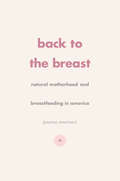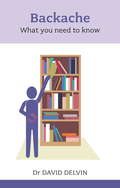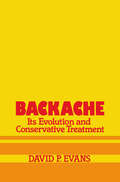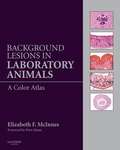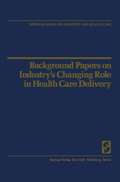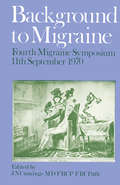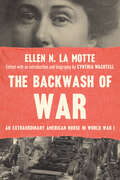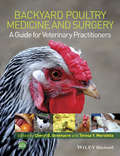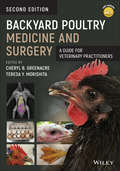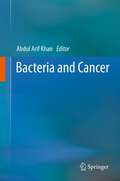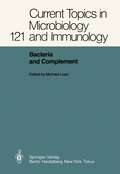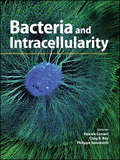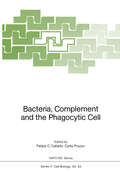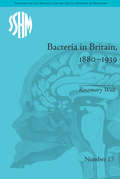- Table View
- List View
Back to the Breast: Natural Motherhood and Breastfeeding in America
by Jessica MartucciAfter decades of decline during the twentieth century, breastfeeding rates began to rise again in the 1970s, a rebound that has continued to the present. While it would be easy to see this reemergence as simply part of the naturalism movement of the ’70s, Jessica Martucci reveals here that the true story is more complicated. Despite the widespread acceptance and even advocacy of formula feeding by many in the medical establishment throughout the 1940s, ’50s, and ’60s, a small but vocal minority of mothers, drawing upon emerging scientific and cultural ideas about maternal instinct, infant development, and connections between the body and mind, pushed back against both hospital policies and cultural norms by breastfeeding their children. As Martucci shows, their choices helped ideologically root a “back to the breast” movement within segments of the middle-class, college-educated population as early as the 1950s. That movement—in which the personal and political were inextricably linked—effectively challenged midcentury norms of sexuality, gender, and consumption, and articulated early environmental concerns about chemical and nuclear contamination of foods, bodies, and breast milk. In its groundbreaking chronicle of the breastfeeding movement, Back to the Breast provides a welcome and vital account of what it has meant, and what it means today, to breastfeed in modern America.
Back to the Breast: Natural Motherhood and Breastfeeding in America
by Jessica MartucciAfter decades of decline during the twentieth century, breastfeeding rates began to rise again in the 1970s, a rebound that has continued to the present. While it would be easy to see this reemergence as simply part of the naturalism movement of the ’70s, Jessica Martucci reveals here that the true story is more complicated. Despite the widespread acceptance and even advocacy of formula feeding by many in the medical establishment throughout the 1940s, ’50s, and ’60s, a small but vocal minority of mothers, drawing upon emerging scientific and cultural ideas about maternal instinct, infant development, and connections between the body and mind, pushed back against both hospital policies and cultural norms by breastfeeding their children. As Martucci shows, their choices helped ideologically root a “back to the breast” movement within segments of the middle-class, college-educated population as early as the 1950s. That movement—in which the personal and political were inextricably linked—effectively challenged midcentury norms of sexuality, gender, and consumption, and articulated early environmental concerns about chemical and nuclear contamination of foods, bodies, and breast milk. In its groundbreaking chronicle of the breastfeeding movement, Back to the Breast provides a welcome and vital account of what it has meant, and what it means today, to breastfeed in modern America.
Backache: What You Need To Know
by Dr. David DelvinBack pain is the largest single cause of sickness absence in the UK, and eighty percent of Britons will suffer from it at some point in their lives. This book looks at the options for back pain, from self-help to medical, with an emphasis on the fact that conventional medicine isn't always the answer.
Background Lesions in Laboratory Animals E-Book: A Color Atlas
by Elizabeth Fiona McInnesBackground Lesions in Laboratory Animals will be an invaluable aid to pathologists needing to recognize background and incidental lesions while examining slides taken from laboratory animals in acute and chronic toxicity studies, or while examining exotic species in a diagnostic laboratory. It gives clear descriptions and illustrations of the majority of background lesions likely to be encountered. Many of the lesions covered are unusual and can be mistaken for treatment-related findings in preclinical toxicity studies. The Atlas has been prepared with contributions from experienced toxicological pathologists who are specialists in each of the laboratory animal species covered and who have published extensively in these areas.over 600 high-definition, top-quality color photographs of background lesions found in rats, mice, dogs, minipigs, non-human primates, hamsters, guinea pigs and rabbits a separate chapter on lesions in the reproductive systems of all laboratory animals written by Dr Dianne Creasy, a world expert on testicular lesions in laboratory animals a chapter on common artifacts that may be observed in histological glass slides extensive references to each lesion described aging lesions encountered in all laboratory animal species, particularly in rats in mice which are used for carcinogenicity studies
Background Papers on Industry’s Changing Role in Health Care Delivery (Springer Series on Industry and Health Care #3)
by Karl T. Benedict John D. Blum Rick J. Carlson G. H. Collings Henry C. Damm Stanley P. DeLisser Henry A. DiPrite C. Larkin Flanagan Willis P. Goldseck William E. Greer Thomas Herriman George Himler Alan C. Monheit Sheldon W. Samvels Mark C. Schofield H. A. Sinclair Jacob Spies Bynum E. TudorExcerpt from Conference Address One of the most complex and significant social issues facing our nation is reform of our national health system. I am personally committed, and Goodyear Tire & Rubber is committed, to doing everything we can to help improve that system while simultaneously gaining some measure of control over the tremen dous rate of cost escalation. I feel very strongly that in the months ahead, business leaders must become actively involved in a concerted effort to strike a balance between our desire to assure the best medical care for all and the reality of doing so at a cost our society can afford. For the past two years I have been chairman of the Business Roundtable's Task Force on Health and in that capacity have been working closely with the Washington Business Group on Health. Through this exposure and the encour aging results of Goodyear's own cost containment activities, I was asked to serve on HEW Secretary Califano's Advisory Committee on National Health Insurance. This committee, representing a broad spectrum of interests and expertise, will be meeting in cities across the country and will hold hearings in Washington before entering into final discussions with HEW and other admin istration officials. The result of its work is to be combined with that of the HEW staff in formulating the basis of President Carter's national health insurance proposal.
Background to Migraine: Fourth Migraine Symposium September 11th, 1970
by CUMINGSThe Fourth Migraine Symposiumheldon September 11th, 1970 was deliberately slanted towards a different audience from the earlier meetings. An attempt was made to interest General Practitioners rather than Scientists in some of the problems associated with diagnosis and therapy in migraine. Y et the volume does include two papers of a more scientific nature and these may be of some interest to those physiologists and biochemists interested in this common disorder. References are those given by each author, but as far as possible they have been checked and are presented here in as uniform a manner as possible. Dr Raymond Greene most kindly acted throughout the entirc meeting as a most excellent Chairman. Our thanks are also due and are given to The Migraine Trust for their part in the organizing of the meeting, to Miss S. Barkwell, my secretary, for her painstaking assist ance, and to the Department of Medical Illustration for preparing the figures in Chapters I, 3, 4 and I 0. November, I970 J. N. CUMINGS Editor viii Chairman: DR RA YMOND GREENE OPENING ADDRESS Sir John Richardson As a generat physician, I am naturally very greatly honoured at being invited tobe the first speaker at this Fourth Symposium of the Migraine Trust. Migraine certainly deserves special study because of the enormous morbidity that it causes throughout the world. I understand that it has been estimated that there are seven million sufferers in this country alone.
The Backwash of War: An Extraordinary American Nurse in World War I
by Ellen N. La Motte"We are witnessing a phase in the evolution of humanity, a phase called War;¢;‚¬;€?and the slow, onward progress stirs up the slime in the shallows, and this is the Backwash of War. It is very ugly.";¢;‚¬;€?Ellen N. La MotteIn September 1916, as World War I advanced into a third deadly year, an American woman named Ellen N. La Motte published a collection of stories about her experience as a war nurse. Deemed damaging to morale, The Backwash of War was immediately banned in both England and France and later censored in wartime America. At once deeply unsettling and darkly humorous, this compelling book presents a unique view of the destruction wrought by war to the human body and spirit. Long neglected, it is an astounding book by an extraordinary woman and merits a place among major works of WWI literature. This volume gathers, for the first time, La Motte's published writing about the First World War. In addition to Backwash, it includes three long-forgotten essays. Annotated for a modern audience, the book features both a comprehensive introduction to La Motte's war-time writing in its historical and literary contexts and the first extended biography of the "lost" author of this "lost classic." Not only did La Motte boldly breach decorum in writing The Backwash of War, but she also forcefully challenged societal norms in other equally remarkable ways, as a debutante turned Johns Hopkins;€“trained nurse, pathbreaking public health advocate and administrator, suffragette, journalist, writer, lesbian, and self-proclaimed anarchist.
The Backwash of War: An Extraordinary American Nurse in World War I
by Ellen N. La Motte"We are witnessing a phase in the evolution of humanity, a phase called War;¢;‚¬;€?and the slow, onward progress stirs up the slime in the shallows, and this is the Backwash of War. It is very ugly.";¢;‚¬;€?Ellen N. La MotteIn September 1916, as World War I advanced into a third deadly year, an American woman named Ellen N. La Motte published a collection of stories about her experience as a war nurse. Deemed damaging to morale, The Backwash of War was immediately banned in both England and France and later censored in wartime America. At once deeply unsettling and darkly humorous, this compelling book presents a unique view of the destruction wrought by war to the human body and spirit. Long neglected, it is an astounding book by an extraordinary woman and merits a place among major works of WWI literature. This volume gathers, for the first time, La Motte's published writing about the First World War. In addition to Backwash, it includes three long-forgotten essays. Annotated for a modern audience, the book features both a comprehensive introduction to La Motte's war-time writing in its historical and literary contexts and the first extended biography of the "lost" author of this "lost classic." Not only did La Motte boldly breach decorum in writing The Backwash of War, but she also forcefully challenged societal norms in other equally remarkable ways, as a debutante turned Johns Hopkins;€“trained nurse, pathbreaking public health advocate and administrator, suffragette, journalist, writer, lesbian, and self-proclaimed anarchist.
Backyard Poultry Medicine and Surgery: A Guide for Veterinary Practitioners
by Cheryl B Greenacre Teresa Y MorishitaBackyard Poultry Medicine and Surgery is a practical resource offering guidance on developing diagnostic and treatment plans for individual companion poultry or small flocks. Organized by body system to aid in developing a differential diagnosis list for common presenting signs, the book provides all the information clinicians need to effectively treat backyard poultry. Written by experts from both the commercial poultry field and the companion avian field, the book provides thorough coverage of both common and less common diseases of backyard chickens, ducks, and other poultry. The book begins with introductory chapters covering general information, an overview of US laws, and basic husbandry concerns, then moves into specific disease chapters organized by system. The book takes an individual medicine perspective throughout, with photographs, radiographs, and histopathological photomicrographs to illustrate principles and diseases. Backyard Poultry Medicine and Surgery is an invaluable guide to diseases and treatments for any practitioners treating backyard poultry.
Backyard Poultry Medicine and Surgery: A Guide for Veterinary Practitioners
by Cheryl B. Greenacre Teresa Y. MorishitaBackyard Poultry Medicine and Surgery is a practical resource offering guidance on developing diagnostic and treatment plans for individual companion poultry or small flocks. Organized by body system to aid in developing a differential diagnosis list for common presenting signs, the book provides all the information clinicians need to effectively treat backyard poultry. Written by experts from both the commercial poultry field and the companion avian field, the book provides thorough coverage of both common and less common diseases of backyard chickens, ducks, and other poultry. The book begins with introductory chapters covering general information, an overview of US laws, and basic husbandry concerns, then moves into specific disease chapters organized by system. The book takes an individual medicine perspective throughout, with photographs, radiographs, and histopathological photomicrographs to illustrate principles and diseases. Backyard Poultry Medicine and Surgery is an invaluable guide to diseases and treatments for any practitioners treating backyard poultry.
Backyard Poultry Medicine and Surgery: A Guide for Veterinary Practitioners
by Cheryl B. Greenacre Teresa Y. MorishitaBackyard Poultry Medicine and Surgery, Second Edition is a thorough revision and expansion of the first book to provide practical information for veterinarians treating individual or small flocks of poultry. With seven new chapters covering toxicology, euthanasia, gross pathology, behavior, game bird medicine, vaccinations, and drugs, and many existing chapters significantly expanded, the book offers a complete guide to all aspects of husbandry, medicine, and surgery for backyard poultry. Organized by organ system for ease of use, the book is designed to support veterinarians in diagnosing and treating backyard chickens, whether they see an occasional bird or regularly treat poultry. More than 400 color photographs aid in breed identification and diagnosis, and the clinical focus enables veterinarians to confidently and knowledgably develop a diagnostic and treatment plan. Chapters are written by leading experts in avian medicine and surgery. Backyard Poultry Medicine and Surgery is a must-have reference for any veterinarian called on to care for backyard flocks, whether they see an occasional chicken or treat poultry regularly. Offers a comprehensive guide to diagnosing and treating backyard poultry Presents practical information on husbandry, medicine, and surgery Written from an individual medicine perspective to aid practitioners in developing a diagnostic and treatment plan for the individual or small flock of poultry Expands significantly on the first edition, with many expanded chapters and seven brand-new chapters Includes new chapters covering toxicology, euthanasia, gross pathology, behavior, game bird medicine, vaccinations, and drugs Provides more color photographs to aid in breed and disease identification
Backyard Poultry Medicine and Surgery: A Guide for Veterinary Practitioners
by Cheryl B. Greenacre Teresa Y. MorishitaBACKYARD POULTRY MEDICINE AND SURGERY An expanded edition that explains the diagnosis and treatment of backyard poultryYou can look to Backyard Poultry Medicine and Surgery, Second Edition for practical veterinary information on the treatment of poultry. You’ll find six new chapters covering radiology, toxicology, euthanasia, gross pathology, behavior, and emergency medicine. The book is written by some of the most respected specialists in a broad range of fields.With many original chapters also significantly expanded, the book provides a complete guide to all aspects of husbandry, medicine, and surgery for poultry. Diseases are organized by body systems to aid in developing a diagnosis. This book supports your work as a practitioner, whether you treat birds occasionally or regularly.Review information on the topics of husbandry, medicine, and surgeryGain guidance on developing a diagnostic or treatment plan for the individual or small flock of poultryChoose appropriate doses of labeled and extra-label drugsFind new chapters on emergency medicine, toxicology, euthanasia, gross pathology, normal and abnormal radiographic findings, and other key topicsUse color photographs to aid in breed identification and poultry disease diagnosesView photographs, videos, and linked references and websites on an accompanying websiteThis is an essential and comprehensive guide providing enhanced and updated information to support all types of practitioners—from the dedicated avian veterinarian to those who rarely treat these species.
Bacteria and Cancer
by Abdul Arif Arif KhanBacterial infections cause substantial morbidity and mortality in cancer patients. These infections always remained enigmatic due to initial reluctance of cancer researchers in understanding their etiologic potential. Etiological association of bacteria with cancer gained credibility after discovery of carcinogenic potential of Helicobacter pylori. Moreover, other suspected associations including Salmonella typhi and gallbladder cancer, Streptococcus bovis and colon cancer, Chlamydia psittaci and ocular adnexal lymphoma and Chlamydia pneumoniae with lung cancer, etc. are looking for a legitimate appraisal to unravel their etiologic potential without prejudice. In contrary, bacteria also show protective role in certain types of cancer. Certain agents derived from bacteria are successfully in practice for the management of cancer. The integrate association of bacteria and cancer is evident in both positive and negative aspects. The role of bacteria in cancer etiology and treatment is vigorously studied since last few years. Present book tries to provide current status of research undergoing in above direction, with the glimpses of future possibility for using microbiological knowledge in the management of this deadly killer.This book will interest specialists dealing with cancer associated infectious complications, researchers working in the field of cancer biology, teachers and scientists in the field of microbiology, biotechnology, medicine and oncology. The unique coverage of bacteriology and cancer association in both positive and negative way can usher into development of novel thrust area for microbiology students and experts.
Bacteria and Complement (Current Topics in Microbiology and Immunology #121)
by Michael LoosDeficiencies in any of the defense mechanisms of the host can lead to severe microbial infections; these are of clinical relevance. Broad up-to-date knowledge in this field allows identification of many unspecific as well as highly specific defense reactions involved in the struggle against infectious diseases. On the other hand, protective structures on the microbial cell surfaces have been adapted and improve the counterpart's chances of survival. In particular, it has been considered that the great diversity of the bacterial envelopes not only determines the anatomical location of the tissue injury but also induces activation of distinct parts of the complex defense system. The specific defense mechanism, whose most prominent constituent is provided by the antibo
Bacteria and Intracellularity (ASM Books)
by Pascale Cossart Craig R. Roy Philippe SansonettiBacteria and Intracellularity clearly demonstrates that cellular microbiology as a field has reached maturity, extending beyond the strictly cellular level to infections of various organs and tissues. Decades of intense investigation into host-bacterial pathogen interactions have highlighted common concepts in intracellularity but also very diverse mechanisms underlying the various infections produced by bacteria. This book offers a wide-ranging look at the latest studies, including: foodborne pathogens, including how, when, and where bacteria interact with the gut and its microbiota infections of the urogenital tract, endothelial barriers, and the nervous system major advances in work with Mycobacterium tuberculosis and M. leprae subcellular microbiology, including metabolism of infected cells, nuclear biology, and microRNAs endosymbionts, in particular the latest work with Wolbachia and its effect on insect transmission of viral pathogens research into cell autonomous defense pathways that has led to major insights into immunology and innate immunity the latest developments in technology, for the next steps in the study of intracellularity All facets of cellular physiology, within the entire scope of cells and host tissues, can be targeted by pathogens. This book offers to researchers, students, and laboratorians a valuable overview of the state of current research into the cellular microbiology of host-pathogen interactions.
Bacteria and Intracellularity (ASM Books)
by Pascale Cossart Philippe Sansonetti Craig R. RoyBacteria and Intracellularity clearly demonstrates that cellular microbiology as a field has reached maturity, extending beyond the strictly cellular level to infections of various organs and tissues. Decades of intense investigation into host-bacterial pathogen interactions have highlighted common concepts in intracellularity but also very diverse mechanisms underlying the various infections produced by bacteria. This book offers a wide-ranging look at the latest studies, including: foodborne pathogens, including how, when, and where bacteria interact with the gut and its microbiota infections of the urogenital tract, endothelial barriers, and the nervous system major advances in work with Mycobacterium tuberculosis and M. leprae subcellular microbiology, including metabolism of infected cells, nuclear biology, and microRNAs endosymbionts, in particular the latest work with Wolbachia and its effect on insect transmission of viral pathogens research into cell autonomous defense pathways that has led to major insights into immunology and innate immunity the latest developments in technology, for the next steps in the study of intracellularity All facets of cellular physiology, within the entire scope of cells and host tissues, can be targeted by pathogens. This book offers to researchers, students, and laboratorians a valuable overview of the state of current research into the cellular microbiology of host-pathogen interactions.
Bacteria, Complement and the Phagocytic Cell (Nato ASI Subseries H: #24)
by Felipe C. Cabello Carla PruzzoPhagocytic cells and complement are probably the most important components of host defense against bacteria which, after overcoming the mucosal and epithelial barriers, multiply in the subepithelial tissue and may threaten to disseminate and invade the blood stream and different organs. Questions concerning the factors which regulate the interactions of the bacterial cell with host defenses are a challenge to research and lead to practical applications for the prevention, treatment and diagnosis of infectious diseases. The questions of expression and regulation of virulence related bacterial genes and gene products, the specific mechanisms of defence reactions by complement and phagocytic cells, their mutual interactions with bacteria and especially bacterial surfaces are focused. Considerations on how to translate this knowledge into the management of infectious diseases are also included.
Bacteria in Britain, 1880–1939 (Studies for the Society for the Social History of Medicine)
by Rosemary WallFocusing on the years between the identification of bacteria and the production of antibiotic medicine, Wall presents a study into how bacteriology has affected both clinical practice and public knowledge.
Bacteria in Britain, 1880–1939 (Studies for the Society for the Social History of Medicine #17)
by Rosemary WallFocusing on the years between the identification of bacteria and the production of antibiotic medicine, Wall presents a study into how bacteriology has affected both clinical practice and public knowledge.
Bacteria in Nature: Volume 3: Structure, Physiology, and Genetic Adaptability (Bacteria in Nature #3)
by Edward R. Leadbetter Jeanne S. PoindexterThe value of studies of monotypic populations is constantly argued in bacterial ecology. The controversy itself is evidenceofthe strong awareness that bacterial activities in natural sites are not determined by the bacteria alone. At the same time, the best evidence that bacteria are influenced by environmental factors is the contrast between their behavior in laboratory cultures and their relatively subdued influence when in the presence of com petitors, predators, and fluctuating-often stressful-environmental conditions. Monotypic populations are admittedly reductionist, but are not therefore irrelevant to bacterial ecology. Quite the contrary. Without pure culture studies, our understanding of important and applicable bacterial activities-N fixation, for example-would still be z limited to what we could discern from a comparison of events in steamed vis-a-vis un heated soil. As was evident throughout the previous volume in this treatise, practically any method of studying natural bacterial communities upsets them while permitting only limited assessment of the respective qualities and quantitative contributions to total com munity activity of each type of bacterium present. Total activity itself is difficult to assess and is not dependably accomplished by any single method. This third volume comprises information regarding the properties of bacteria as they have been learned largely from pure culture studies. Its purpose is twofold: to provide readers with fundamental information regarding the cellular organization, physiological capabilities, and genetic systems of bacteria; and to connect known bacterial properties with environmental influences on them and with their influences on natural processes.
Bacteria in Nature: Volume 1: Bacterial Activities in Perspective (Bacteria in Nature #1)
by Edward R. Leadbetter Jeanne S. PoindexterAny branch of biology depends for its progress on the development of new concepts and to a lesser, but sometimes crucial, extent on the elimination of erroneous notions. Understanding the roles of bacteria required first the observation that such minute creatures existed, and subsequently the exper imental demonstrations that their presence was necessary for the occurrence of particular phenomena. In this first volume, the authors review the development of scientific understanding of the role of microbes as agents of diverse natural processes. Notably absent is a separate review of the history of microbes as agents of disease, a his tory available in many other publications. Regrettably absent is a review of the his tory of microbes as agents of inorganic transformations, a serious omission that resulted from the illness of the prospective author late in the preparation of this volume. The topic will of course be treated in later volumes, although not predominantly in a historical manner. Otherwise, the emphasis in this volume is on the history of understanding interrelationships between modes of bacterial existence and the inanimate environment. These relationships were established long be fore multicellular, differentiated or ganisms appeared as potential microbial habitats, and their recognition and elucidation contributed greatly to the widened appreciation of bacterial di versity and the importance of these simpler creatures to the physiochemical conditions of the biosphere.
Bacterial Activation of Type I Interferons
by Dane ParkerThe type I interferon (IFN) signaling pathway is well recognized as a pathway activated by viral infections. It is activated by a variety of microbial pattern recognition receptors including the Toll-like receptors, NOD-like receptors and several cytosolic receptors. Activation of the type I IFN pathway leads to the production of both antiviral factors and products that influence immune cell function. More recently it has been shown that bacteria are also capable of activating this pathway.Bacterial Activation of Type I Interferons reviews both the current understanding of how different bacterial species are able to activate this pathway as well as the influence type I IFNs have on the outcome to infection. Several different bacterial species are covered, spanning Gram positive and Gram negative, intracellular, extracellular, and different host infection sites. An introduction to the pathogenesis of each organism is provided, and the signaling molecules involved in the activation of the type I IFN pathway and the role it plays in animal infection models are also covered.
Bacterial Adhesion: Chemistry, Biology and Physics (Advances in Experimental Medicine and Biology #715)
by Dirk Linke and Adrian GoldmanOver the last few years, bacterial adhesion has become a more and more important and active scientific area, but the field lacks communication and scientific exchange between medical and microbiology researchers who work with the relevant biological systems, and biochemists, structural biologists and physicists, who know and understand the physical methods best suited to investigate the phenomenon at the molecular level. The field consequently would benefit from a cross-disciplinary conference enabling such communication. This book tries to bridge the gap between the disciplines.
Bacterial Adhesion: Mechanisms and Physiological Significance
by M. Fletcher D. C. SavageStudy of the phenomena of bacterial adhesion to surfaces has accelerated considerably over the past 10 to 15 years. During this period, microbiologists have become increasingly aware that attachment to a substratum influences considerably the activities and structures of microbial cells. Moreover, in many cases attached communities of cells have important effects on their substratum and the surrounding environment. Such phenomena are now known to be important in plant and animal hosts, water and soil ecosystems, and man-made structures and industrial processes. Much work on microbial adhesion in the early 1970s was descriptive. Those studies were important for detecting and describing the phenomena of bacterial adhesion to substrata in various environments; the findings have been presented in numerous recently published, excellent books and reviews. In some studies, attempts were made to elucidate some funda mental principles controlling adhesion processes in different environments containing a variety of microorganisms. Common threads have been observed occasionally in different studies. Taken as a whole, however, the information has revealed that many disparate factors are involved in adhesion processes. Whether a particular microorganism can adhere to a certain substratum depends on the properties of the microbial strain itself and on charac teristics of the substratum and of the environment.
